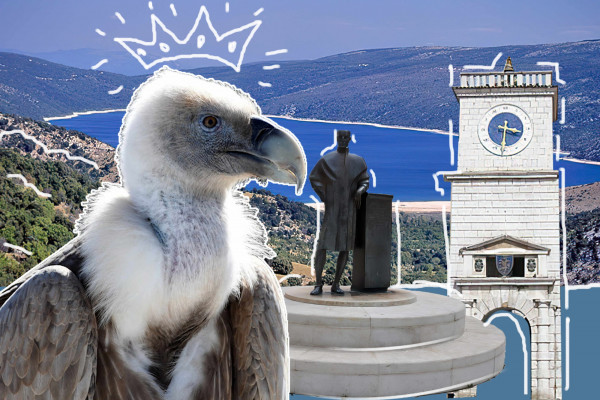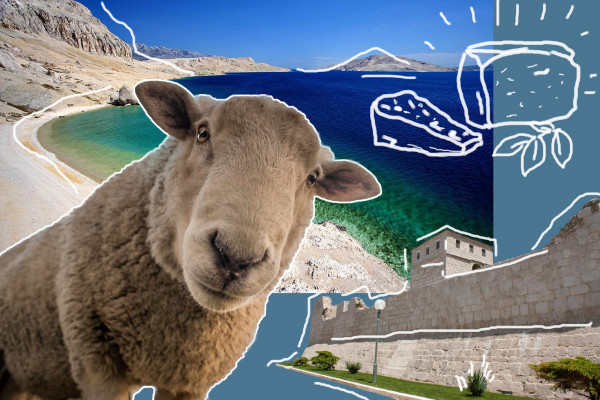Show all photos
Geopark Vis Archipelago guide - explore the island paradise
The island of Vis and its archipelago are a part of the Global UNESCO Geopark Network - a network dedicated to sustainable development of all areas in the world that are geologically or geomorphologically important. Vis and the islands surrounding it are incredibly rich in natural beauty, significant landscapes, pristine sea, caves with natural phenomena occurring in them, volcanic islands and endemic species. We have prepared a short guide that will take you through all the protected areas and geomorphological monuments of nature in the Geopark Vis Archipelago, and hopefully inspire you to visit it.
1.The island of Biševo may be one of the smaller islands of the Geopark Vis Archipelago, but it is perhaps one of the richest in natural beauty. Aside from historical heritage, the Church of St. Sylvester and the ruins of a Benedictine monastery, it is best known for its caves.
The better known of the two is the Blue Cave, a must-see for anyone visiting Vis. It would perhaps never have been such a popular location had it not been for the baron von Ransonet, the Viennese painter who painted it. Just like everyone else who’s been visiting the cave since 1884, he was enchanted by the almost unique magical phenomenon occurring in the cave during daytime. The sunlight enters the cave through an underwater opening and illuminates the cave with a blue light (occasionally a silvery glow, too). This impressive sight put the cave on the top of the go-to tourist locations on the island of Vis and is responsible for the 1951 decision to have it protected as a geomorphological monument of nature.
Equally valuable and lovely is the Medvidina Cave (or, the Monk Seal Cave). It used to be the home of the Mediterranean monk seal (which is how it got its name) and because of this it was given the status of a geomorphological monument of nature in 1967. It is 160 meters long and also the longest sea cave on the Adriatic. In its depths is a small strand that can only be reached by smaller boats.
2. The island of Brusnik is a small volcanic island, only two hundred meters long. Like its sister island, Jabuka, it is composed of sub-volcanic diabase formed by lava crystallization. Its rocks are full of magnetite, and in its center you will find a small gorge with a pool of sea water. In the old days, the fishermen of Komiža used it to keep the lobsters they caught fresh.
Brusnik is home to the endemic black lizard. In 1951 it was declared a protected geological monument of nature, due to its exceptional and complex petrographic structure.
3. The island of Svetac, or the island of Sveti Andrija, may be mostly uninhabited today, but in the ancient times it was quite a busy place. It was visited by the Greeks and Romans (various, though rare, finds from this era testify to this), and legend has it that the Illyrian queen Teuta built her fortress here. That is why this island is often called Teuta’s Island.
Along with the remains of Teuta's tower, the island of Svetac has a lovely church of St. Andrew, built in the fifteenth century. Although the island is visited by tourists, its best known inhabitants are the Eleonora's falcon and the Euroasian owl.
4. The islet of Jabuka is the most remote of Croatian islands, sitting at about thirty miles from the coast of Komiža. Like Brusnik, Jabuka is a volcanic island, with igneous rocks full of magnetite. The sea around this islet is too deep to anchor and its rocks too smooth for a boat to be moored. That is why the sea is rich in fish, and why Jabuka is a sanctuary for the endemic black lizard. In 1958, this volcanic rock was declared a geological monument of nature.
5. The Stiniva Bay (along with its beach) is another geologically important area, protected as a significant landscape in 1967. This bay formed during the Ice age, with the sea relentlessly hitting against the rocks and moulding them into a cave. Millions of years later, the cave collapsed, leaving tall rocks rising at the sides of the bay’s beach.
6. The little island of Ravnik is located on the south-east side of the Vis coast and has been protected as a significant landscape since 1967. Due the close proximity of the mainland and the untouched nature that adorns it, it is a popular destination for all those looking for an adventure on their holiday. Its star is the Green Cave where the sunlight, upon entering the cave, creates an enchanting green light. The Green Cave has been a protected geomorphological monument since 1967.
7. Palagruža is another almost uninhabited remote islet in the Adriatic Sea: the only people on it are the lighthouse keepers. Their company on this solitary rock are lizards, and several rare endemic plants.
This reef is actually the crown of a rock structure below the sea’s surface, parts of which date back to 220 million years ago. Due to the favourable and mild climate with very little precipitation, the vegetation on this islet can be classified as subtropical vegetation. Regardless of its rather remote location, you can book a holiday at the Palagruža lighthouse.
Guide Type
Combined
Itinerary
Island of Bishevo , place 1
The Church of Saint Sylvester
Island of Bishevo , place 1
The Church of Saint Sylvester
The small island of Bishevo is only about fifteen minutes away by boat from Komizha, so you might like to pay a visit to its church and monastery. The church, dedicated to Saint Silvester, was built around the middle of the 11th century at the request of Ivan Gaudi Grlich, a priest from Split. After its completion he gifted the church to the Benedictine monks of the island of Tremiti who, in turn, built a monastery next to the church.
Island of Bishevo, place 2
The Blue Cave
Island of Bishevo, place 2
The Blue Cave
The Blue Cave is a must-see for anyone visiting Vis. It would perhaps never have been such a popular location had it not been for the baron von Ransonet, the Viennese painter who painted it. Just like everyone else who’s been visiting the cave since 1884, he was enchanted by the almost unique magical phenomenon occurring in the cave during daytime. The sunlight enters the cave through an underwater opening and illuminates the cave with a blue light (occasionally a silvery glow, too).
island of Bishevo, place 3
The Monk Seal Cave
island of Bishevo, place 3
The Monk Seal Cave
Equally valuable and lovely is the Medvidina Cave (or, the Monk Seal Cave). It used to be the home of the Mediterranean monk seal (which is how it got its name) and because of this it was given the status of a geomorphological monument of nature in 1967. It is 160 meters long and also the longest sea cave on the Adriatic. In its depths is a small strand that can only be reached by smaller boats.
Island 2
The island of Brusnik
Island 2
The island of Brusnik
The island of Brusnik is a small volcanic island, only two hundred meters long. Like its sister island, Jabuka, it is composed of sub-volcanic diabase formed by lava crystallization. Its rocks are full of magnetite, and in its center you will find a small gorge with a pool of sea water. In the old days, the fishermen of Komiža used it to keep the lobsters they caught fresh.
Island 3
The island of Svetac
Island 3
The island of Svetac
The island of Svetac, or the island of Sveti Andrija, may be mostly uninhabited today, but in the ancient times it was quite a busy place. It was visited by the Greeks and Romans (various, though rare, finds from this era testify to this), and legend has it that the Illyrian queen Teuta built her fortress here. That is why this island is often called Teuta’s Island.
Island 5
The Stiniva Bay
Island 5
The Stiniva Bay
The Stiniva Bay (along with its beach) is another geologically important area, protected as a significant landscape in 1967. This bay formed during the Ice age, with the sea relentlessly hitting against the rocks and moulding them into a cave. Millions of years later, the cave collapsed, leaving tall rocks rising at the sides of the bay’s beach.
Island 6
Ravnik Island
Island 6
Ravnik Island
The little island of Ravnik is located on the south-east side of the Vis coast and has been protected as a significant landscape since 1967. Due the close proximity of the mainland and the untouched nature that adorns it, it is a popular destination for all those looking for an adventure on their holiday. Its star is the Green Cave where the sunlight, upon entering the cave, creates an enchanting green light.
Island 6 , Special place
The Green Cave
Island 6 , Special place
The Green Cave
For all lovers of nature, the small island of Ravnik, situated across from the southern coast of the island of Vis, has a particularly lovely site to offer. Its Green Cave, a beauty of untouched nature, has been a protected natural landmark since 1967. It gets its name from the greenish light created when the sunlight, coming through the opening in the cave’s dome, hits the bottom of the sea covered with green algae.
Guide Location
Traveler type
All types of travelers
Reviews
4.5/5
Excellent
Based on
14 reviews
Excellent
7
Very Good
7
Average
0
Poor
0
Terrible
0
Winter
03/01/2022
The Church of Saint Sylvester was built in the 11th century at the request of Gaudi Grlich. The guide gives a chronological and detailed history of this monumental location. I loved the Pre-Romanesque architectural style incorporated in the construction. It was a great learning experience visiting this location.
Elsi
31/12/2021
The guide is very illustrative. It led us to some of the great spots in this island. For instance, through its help i was able to visit the Island of Svetac, Palagruza and the island of Ravnik.
Aubrie
25/12/2021
The guide inspired us to visit all the protected areas and geomorphological monuments of nature in here. We toured the caves at the Island of Bisevo and we were mesmerized by the magical beauty of nature. The guide elaborated the magic of Blue Cave during the day.
Mateo
25/12/2021
very good!!!
Ben
18/12/2021
This is a guide of all Islands surrounding the Islands of Vis. I enjoyed using this guide. It gave me an adventurous experience touring the Islands. The guide gives a well detailed information of all the Islands even their geological information. The islands were so beautiful.
Michel
13/12/2021
Touring the Island of paradise was an amazing moment thanks to the guide. I was aware of the places I was to visit . The Islands were many I did not get to visit all of them but I wish I visited all of them.
Uli
01/12/2021
The guide was detailed, it had rich information about specific locations. We toured the Islet of Jabuka where we saw the endemic black lizard. My Geography students were elated to find a reef in reality away from the theory taught in class.
Showing 1 - 7 of 14 total













